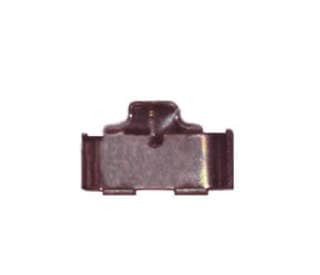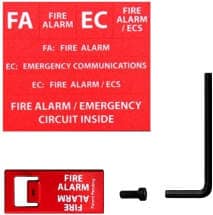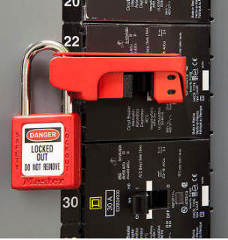 Circuit Breaker Locks
Circuit Breaker Locks
Definitions, code citations, uses of lockouts & LOTOS on circuit breakers
- POST a QUESTION or COMMENT about this article topic.
This article describes the use of locking devices on circuit breakers.
Circuit breaker locks are installed to prevent the accidental or deliberate switching off of certain electrical circuits.
Page top photo: a circuit breaker lock installed on a Square-D circuit breaker, appropriately colored red and tagged. This breaker lock can be opened only by a key. Other circuit breaker locks can be removed by using not a key but perhaps a special tool.
InspectAPedia tolerates no conflicts of interest. We have no relationship with advertisers, products, or services discussed at this website.
- Daniel Friedman, Publisher/Editor/Author - See WHO ARE WE?
Circuit Breaker Locks & LOTOs
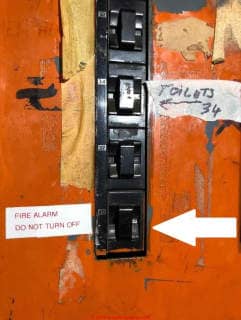 Here we define the types of circuit breaker locking devices, cite the electrical code provisions governing their use, and discuss safety and other concerns with the use, testing, or inspecting of circuit breaker locking or turn-off prevention devices.
Here we define the types of circuit breaker locking devices, cite the electrical code provisions governing their use, and discuss safety and other concerns with the use, testing, or inspecting of circuit breaker locking or turn-off prevention devices.
[Click to enlarge any image]
Question: add NFPA approved lock to the breaker for the dedicated fire alarm circuit?
2019/05/22 Fab87JCI said:
Been looking everywhere but to no avail. Maybe someone here could help please...
A picture attached shows an old school pushmatic breaker. Is there an option to add some kind of NFPA approved lock to the breaker for the dedicated fire alarm circuit??
All I'm finding is locks for the standard modern breakers but none for these really old ones.
Replacing the Pushmatic brand circuit breaker panel is not much of an option at this point.
Thanks in advance!
Reply:
Fab
Siemens produces a PHL1 Siemens ITE Pushmatic Handle Lock Kit - shown below.
Part No. 0829079769 and UPC 30783643118554 selling for about $15. U.S.
I’ve seen the Pushmatic breaker lock sold at online vendors and you may also find it through your local electrical supplier. Basically it’s a screw-locked clip that prevents the user from pushing the Pushmatic breaker in or “down” without first using a tool (a tiny allen wrench) to remove the guard.
Watch out however: you should reconsider your position that you will not replace the Bulldog Pushmatic panel as there are known performance and safety concerns with those breakers.
See details at PUSHMATIC - BULLDOG PANELS
For other readers:
Explanation of Circuit Breaker Locking Devices
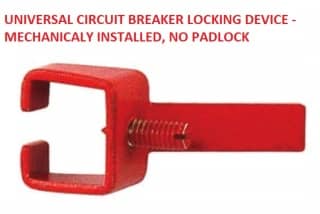 Any form of circuit breaker lock that prevents the breaker from being switched off by building occupants might seem to be in violation of NEC 422.30 or 422.34 and similar sections that require a disconnecting means for all appliances and similar code provisions requiring that the breaker be readily accessible - which means it can be switched off without special tools and that it can be accessed by building occupants.
Any form of circuit breaker lock that prevents the breaker from being switched off by building occupants might seem to be in violation of NEC 422.30 or 422.34 and similar sections that require a disconnecting means for all appliances and similar code provisions requiring that the breaker be readily accessible - which means it can be switched off without special tools and that it can be accessed by building occupants.
Shown here: a simple set-screw locking device sold as a "universal" circuit breaker lock, produced by Garvin Industries, website: www.garvinindustries.com
[Click to enlarge any image]
However there is an important exception to the conventional “readily-accessible” rule for electrical circuit breakers.
Some critical circuits must not be turned off by normal building occupants, such as fire alarm circuits. To prevent that action on a fire alarm circuit that is located in an electrical panel whose other breakers MUST indeed be readily accessible and able to be switched off an electrician may install a circuit breaker lock.
Circuit breaker locks are mechanical or key or padlock secured mechanical covers that prevent an individual circuit breaker from
being deliberately or accidentally flipped “off” by un-qualified (un-authorized) personnel. That’s to assure that critical life-safety
electrical circuits such as those used to power a building fire alarm system are not switched off.
Watch out: most of the circuit breaker locking devices that I found when researching for this article appear to be intended to lock a circuit breaker OFF to permit work on the circuit.
Those are not the same as devices intended to leave the electrical circuit ON and to permit the breaker to TRIP OFF in the event of an overcurrent.
Watch out:There are also lockout devices both commercially sold and home made that might actually prevent the breaker from tripping in response to an over-current. Such devices are improper and unsafe. A “snap on” or “temporary locking device” (LOTO devices) used for example by a contractor working on an electrical circuit would not be code compliant - at least for permanent installation.
Electrical code citations pertinent to circuit breaker locks
NEC 110.25 Lockable Disconnecting Means
 Don't confuse temporary lockout devices with permanently-installed circuit breaker locks intended to let the breaker function but to prevent manual switching of the circuit to the OFF position.
Don't confuse temporary lockout devices with permanently-installed circuit breaker locks intended to let the breaker function but to prevent manual switching of the circuit to the OFF position.
Shown here: a fire alarm circuit breaker safety lock produced by Space Age Electronics, sold as ECLIPS ELOCK-FA, E-SERIES ELOCK FIRE LOCKOUT KIT - CIRCUIT BREAKER LOCK and available from electrical suppliers.
This kit is intended for use on fire alarm circuits and it should permit the breaker to trip off in response to an overcurrent. It requires a tool (an allen wrench) to install or remove but it is not pad-locked.
Paraphrasing a description of a true circuit breaker locking device as would be used on a fire alarm circuit:
The means to lock the switch or circuit breaker in the open position must be an integral part of the enclosure or be an accessory that is not readily removed from the switch or circuit breaker.
Watch out: Portable locking mechanisms that are intended for temporary applications are not acceptable means of compliance
NFPA 70- 760.41 (B)- Non-Power limited, & 760.121(B) Power limited, the branch circuit supplying fire alarm equipment shall be identified in red and labeled "Fire Alarm Circuit" and shall be accessible only to qualified personnel.
NFPA-72 10.6.5.4 … a listed circuit breaker locking device be installed on the branch circuit supplying fire alarm equipment.
The US NEC requirement that “tools” or “special tools” be required to open or remove the circuit breaker lock is intended to protect against accidental, un-authorized, or malicious-mischief turning off of such circuits.
Watch out: there may be confusion in the field between a true circuit breaker locking device such as would be installed on a fire alarm circuit and temporary locking devices.
Above: labeling included with the Eclipse fire alarm breaker locking kit. This device sells for under $10. U.S.
Below we includer a typical product description, this from Eaton Cutler Hammer’s April 2016 catalog CA080104001E p. 27.1-8
Watch out: it is not clear to me [DF] that this product is fully compliant with UL 489 as a permanently-installed safety device to prevent breaker operation by un-qualifed people, as I cannot see that the ON-OFF status of the breaker will be visible when this cover has been installed.
The inclusion of the "easy to carry and store" remark in the product description suggests that THIS locking device is NOT intended for PERMANENT installation of a circuit breaker lock as discussed in this article.
Rather it may be intended for temporary installation to protect contractors working on a device or circuit.
Here is the company's product description, excerpted from GlobalIndustrial.com 2019/05/22.
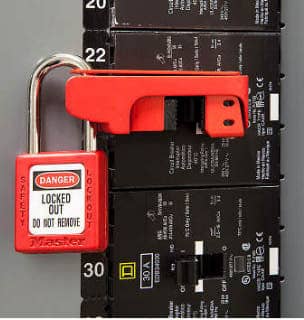 The Master Lock® No. 493B Grip Tight™ Circuit Breaker Lockout Device fits standard height and tie-bar toggles typically found on 120 and 240 volt breakers. The innovative patented Grip Tight™ design effectively locks out circuit breakers with a simple thumb turn and then close clamping handle for a tight grip on the toggle.
The Master Lock® No. 493B Grip Tight™ Circuit Breaker Lockout Device fits standard height and tie-bar toggles typically found on 120 and 240 volt breakers. The innovative patented Grip Tight™ design effectively locks out circuit breakers with a simple thumb turn and then close clamping handle for a tight grip on the toggle.
Device accepts all American Lock® and Master Lock® safety padlocks and most lockout hasps for full lockout. Durable construction stands up in harsh environments and compact design is easy to carry and store.
Padlockable Handle Lock Hasp
The padlockable handle lock hasp allows the handle to be locked in the ON or OFF position. (Trip-free operation allows the circuit breaker to trip when the handle lock holds the circuit breaker handle in the ON position.)
The hasp mounts on the circuit breaker cover within the trim line.
The cover is predrilled on both sides of the operating handle so that the hasp can be mounted on either side of the handle. The hasp will accommodate up to three padlocks with 1/4-inch (6.4 mm) shackles. One per circuit breaker. (Field installation only.)
Key Interlock Kit (Lock Not Included) The key interlock is used to externally lock the circuit breaker handle in the OFF position.
When the key interlock is locked, an extended deadbolt blocks movement of the circuit breaker handle. Uniquely coded keys are removable only with the deadbolt extended.
Each coded key controls a group of circuit breakers for a given specific customer installation.
The key interlock assembly consists of a mounting kit and a purchaser supplied deadbolt lock.
The mounting kit comprises a mounting plate, which is secured to the circuit breaker cover in either the left- or right-pole position; key interlock mounting hardware; and a wire seal.
Specific mounting kits are required for individual key interlock types. (Field installation only.)
For general readers here is a definition of circuit breaker, adapated from Rockwell Automation but also widely used
Circuit Breaker Locking Device Features
From UL489: a circuit breaker locking device must achieve the following:
- Accommodate a padlock [or other means] that will prevent the operation of the circuit breaker or switch with the padlock in place - that means prevent switch operation by non-qualifed people
- Require the use of a tool for removal - a non-qualified person can't simply remove the lock-off
- Be properly labeled itself as wellas permitting viewing of the ON-OFF marking for the circuit breaker position on the breaker itself or on the add-on device. Often these devices are painted red and/or an appropriate add-on label is provided for posting in the panel.
- Not interfere with the normal intended operation of the circuit breaker or switch; the breaker must be able to trip off in response to an overcurrent.
- Be strong enough that it can't simply be subverted or popped off or fail to prevent manual opeation of the switch
- Be self-retaining, that is it will not depend on the panel enclosure cover to retain the device in place
Definition of circuit breaker
A device that is designed to open and close a circuit by non-automatic means, and to open the circuit automatically on a pre-determined overcurrent, without damage to itself when properly applied within its rating.
In the US, the device must have an approval to UL 489. In Canada, the device must be approved to CSA 22.2 No. 5. In IEC regions, the approval is to either IEC 60 898 or IEC 60 047-2
...
Continue reading at CIRCUIT BREAKER HANDLE TIES or select a topic from the closely-related articles below, or see the complete ARTICLE INDEX.
Or see
Suggested citation for this web page
CIRCUIT BREAKER LOCKS at InspectApedia.com - online encyclopedia of building & environmental inspection, testing, diagnosis, repair, & problem prevention advice.
Or see this
INDEX to RELATED ARTICLES: ARTICLE INDEX to ELECTRICAL INSPECTION & TESTING
Or use the SEARCH BOX found below to Ask a Question or Search InspectApedia
Ask a Question or Search InspectApedia
Try the search box just below, or if you prefer, post a question or comment in the Comments box below and we will respond promptly.
Search the InspectApedia website
Note: appearance of your Comment below may be delayed: if your comment contains an image, photograph, web link, or text that looks to the software as if it might be a web link, your posting will appear after it has been approved by a moderator. Apologies for the delay.
Only one image can be added per comment but you can post as many comments, and therefore images, as you like.
You will not receive a notification when a response to your question has been posted.
Please bookmark this page to make it easy for you to check back for our response.
IF above you see "Comment Form is loading comments..." then COMMENT BOX - countable.ca / bawkbox.com IS NOT WORKING.
In any case you are welcome to send an email directly to us at InspectApedia.com at editor@inspectApedia.com
We'll reply to you directly. Please help us help you by noting, in your email, the URL of the InspectApedia page where you wanted to comment.
Citations & References
In addition to any citations in the article above, a full list is available on request.
- Our recommended books about building & mechanical systems design, inspection, problem diagnosis, and repair, and about indoor environment and IAQ testing, diagnosis, and cleanup are at the InspectAPedia Bookstore. Also see our Book Reviews - InspectAPedia.
- In addition to citations & references found in this article, see the research citations given at the end of the related articles found at our suggested
CONTINUE READING or RECOMMENDED ARTICLES.
- Carson, Dunlop & Associates Ltd., 120 Carlton Street Suite 407, Toronto ON M5A 4K2. Tel: (416) 964-9415 1-800-268-7070 Email: info@carsondunlop.com. Alan Carson is a past president of ASHI, the American Society of Home Inspectors.
Thanks to Alan Carson and Bob Dunlop, for permission for InspectAPedia to use text excerpts from The HOME REFERENCE BOOK - the Encyclopedia of Homes and to use illustrations from The ILLUSTRATED HOME .
Carson Dunlop Associates provides extensive home inspection education and report writing material. In gratitude we provide links to tsome Carson Dunlop Associates products and services.


